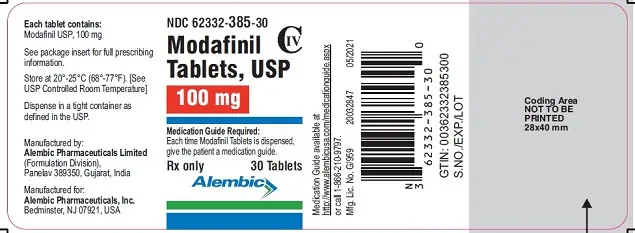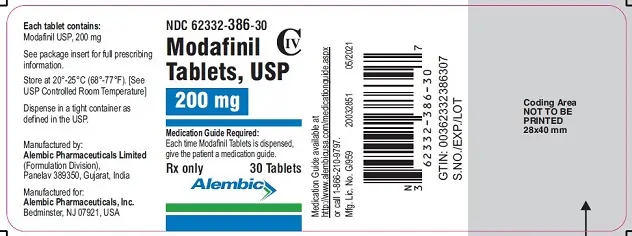What is Modafinil?
Modafinil is a prescription medication often recognized as a wakefulness-promoting agent. It’s primarily prescribed to combat excessive sleepiness caused by specific medical conditions such as narcolepsy, obstructive sleep apnea (OSA), and shift work sleep disorder (SWD). Unlike traditional stimulants, modafinil offers a unique approach to regulating sleep and wake cycles, making it a preferred option for those who require sustained wakefulness during critical times.
You might wonder, “How does it work, and what sets it apart?” Let’s dive into the specifics to understand its role, purpose, and key features.
How Does Modafinil Work?
The exact mechanism behind modafinil’s wakefulness-promoting effects isn’t entirely understood, but scientists do know this: it influences the brain’s natural chemicals responsible for regulating sleep and wakefulness. Modafinil interacts with the dopamine transporter, preventing dopamine reuptake and thereby increasing its levels in specific brain regions. Essentially, it acts as a central nervous system stimulant — but with a twist. Unlike amphetamines, which flood the brain with dopamine, modafinil’s effects are more subtle and targeted, resulting in fewer side effects like jitteriness.
What Conditions Does Modafinil Treat?
Modafinil has earned its place as a solution for several medically recognized sleep disorders. Here’s how it helps:
- Narcolepsy: For individuals experiencing sudden and uncontrollable sleep episodes during the day, modafinil serves as a vital tool to maintain wakefulness and remain productive.
- Obstructive Sleep Apnea (OSA): Although it doesn’t address the root problem of airway obstruction, modafinil alleviates the resulting excessive daytime sleepiness when used alongside other treatments like CPAP machines.
- Shift Work Sleep Disorder (SWD): If your work hours disrupt your body’s natural sleep rhythm, modafinil can help align your alertness with your schedule, reducing fatigue during inconvenient hours.
For more specifics about its usage, check out Modafinil Information.
Why is Modafinil Unique?
Unlike traditional stimulants, modafinil’s design focuses on improving alertness without significantly altering cardiovascular functions. This makes it a popular choice for patients who need energy boosts without heightened risks of anxiety, dependency, or severe withdrawal symptoms. Additionally, modafinil carries a lower abuse potential due to its controlled dopamine activity, which sets it apart from other CNS stimulants like amphetamine-based medications.
Key Considerations Before Taking Modafinil
Before starting modafinil, it’s essential to discuss your medical history with a healthcare professional. This medication is not suitable for everyone. Here’s why:
- Allergic Reactions: Those with a history of hypersensitivity to modafinil or armodafinil should avoid it.
- Heart Conditions or High Blood Pressure: Modafinil may worsen certain cardiovascular issues, requiring monitoring.
- Mental Health Concerns: Patients with anxiety, depression, or psychosis should use modafinil cautiously, as it can exacerbate symptoms.
- Medication Interactions: Hormonal contraceptives may become less effective when used with modafinil, and other drug interactions may also pose risks.
Want to dig deeper into potential side effects? Visit Modafinil Uses, Side Effects & Warnings.
A Controlled Substance with Serious Potential
Did you know modafinil is classified as a Schedule IV controlled substance? This means it has recognized medical uses but could lead to dependency if misused. Physicians carefully monitor prescriptions to ensure safety and effectiveness, particularly for individuals with histories of substance abuse. Proper use under medical guidance is crucial to minimizing risks.
With that said, modafinil isn’t just about fighting sleep disorders. In some cases, it’s used off-label for conditions like attention deficit hyperactivity disorder (ADHD) or fatigue in chronic illnesses. However, these uses aren’t well-documented, and caution is advised. Always consult with your doctor before considering modafinil for any non-approved indications.
Uses
Modafinil is most widely recognized for its ability to promote wakefulness, but its therapeutic applications go beyond simply helping you stay awake. Whether you’re dealing with excessive sleepiness due to a sleep disorder or exploring its off-label functions, understanding its uses can provide better clarity on how this medication works within a structured treatment plan. Let’s dive into the key conditions for which modafinil is prescribed and its additional potential applications.
Primary Uses of Modafinil
Modafinil has FDA approval for the treatment of three specific sleep-related disorders. Here’s how it fits into each condition:
- Narcolepsy: If you find yourself suddenly and uncontrollably falling asleep throughout the day, narcolepsy might be the culprit. Modafinil helps individuals manage the overwhelming daytime drowsiness associated with this neurological condition, giving you the ability to stay alert during critical moments.
- Obstructive Sleep Apnea (OSA): OSA causes interruptions in breathing during sleep, often leading to severe fatigue during the day. While modafinil doesn’t address the actual airways’ obstruction, it is effective for combating the residual sleepiness that persists even after managing the condition with tools like a CPAP machine.
- Shift Work Sleep Disorder (SWD): If your work hours disrupt your body’s natural sleep rhythm — think night shifts or irregular schedules — you might find it hard to stay awake when you need to perform. Modafinil can improve alertness during these misaligned hours, offering a sense of normalcy to your routine.
Off-Label and Emerging Uses
Doctors occasionally prescribe modafinil for conditions outside of its original FDA-approved uses. While these applications are less established, they have shown promise in specific situations:
- Attention Deficit Hyperactivity Disorder (ADHD): Though not officially approved, some studies suggest modafinil may help improve focus and manage ADHD symptoms in adults. It is particularly considered in cases where traditional stimulant medications may not be suitable.
- Chronic Fatigue Syndrome (CFS): For those grappling with persistent, unexplained fatigue, modafinil might serve as a tool to boost daytime energy levels.
- Multiple Sclerosis-Related Fatigue: MS patients often experience debilitating fatigue, and modafinil has been explored as an option to help counteract this symptom.
If you’re curious about how modafinil compares to other medications, check out this in-depth Modafinil vs Provigil Comparison.
What Makes Modafinil Stand Out?
Unlike other stimulants that flood your system and can lead to jitteriness or dependency, modafinil works differently. It promotes wakefulness through selective pathways in the brain. This mechanism allows it to address sleepiness without some of the intense side effects associated with amphetamines or similar drugs.
Whether you’re navigating an irregular work schedule or managing a sleep disorder tied to a chronic condition, modafinil offers a well-rounded solution. That said, this medication should always be taken under close medical supervision to ensure safe and effective use.
Side Effects of Modafinil
When considering modafinil as a treatment, understanding potential side effects is crucial for making an informed decision. Like any medication, modafinil comes with risks that vary from mild discomfort to serious health concerns. Learning about these side effects can help you recognize when to seek medical advice or adjust your treatment.
Common Side Effects
The more frequently reported side effects of modafinil are typically mild and manageable. These are usually temporary and may fade as your body adjusts to the medication. Among the most common issues, you might experience:
- Headache: Often cited as the number one complaint, headaches can range from mild to moderate in intensity.
- Nausea: Some users report queasiness or an upset stomach, especially when taking the medication on an empty stomach.
- Nervousness and Anxiety: Heightened feelings of restlessness or unease may occur, particularly in the beginning.
- Trouble Sleeping: Ironically, a wakefulness-promoting agent like modafinil can sometimes cause insomnia if taken too late in the day.
- Dizziness and Fatigue: Balance and energy levels may feel off, especially during the first few uses.
If you want a comprehensive list of side effects and tips on managing them, check out Modafinil Side Effects: Common, Severe, Long Term.
Serious Side Effects to Watch For
While uncommon, modafinil can also cause severe side effects that warrant immediate medical attention. These are rare but should not be ignored:
- Skin Rash or Stevens-Johnson Syndrome (SJS): If you develop a severe rash or your skin starts to blister, discontinue use immediately and contact your doctor. This can be life-threatening if untreated.
- Cardiovascular Symptoms: Look out for chest pain, palpitations, or shortness of breath, especially if you have a history of heart issues.
- Mental Health Changes: Modafinil may trigger depression, hallucinations, mania, or suicidal thoughts, particularly in those with preexisting mental health conditions.
- Severe Allergic Reactions: Symptoms such as swelling of the face, lips, or throat, as well as difficulty breathing, indicate a need for urgent care.
Detailed information about such risks can also be found at modafinil disease interactions.
Rare but Notable Side Effects in Children
Interestingly, modafinil is not approved for use in pediatric patients, but in rare cases where it has been used, specific side effects have emerged. These include:
- Tourette’s Syndrome: Uncommonly associated with use, especially in cases of off-label prescriptions for children.
- Hostility and Aggression: Behavioral changes that require immediate discussion with a healthcare provider.
- Suicidal Thoughts: As with adults, psychiatric monitoring is essential.
Tips to Minimize Risks
You’re probably wondering: how can you reduce the likelihood of experiencing side effects? The following strategies can help:
- Stick to Prescribed Dosages: Never take more than the recommended dose. Overdosages can lead to severe symptoms like confusion, hallucinations, and heart problems.
- Time Your Dose Correctly: Take modafinil early in the morning to avoid nighttime disruptions.
- Monitor Interactions: Combining modafinil with other medications, including hormonal contraceptives, may heighten side effects or reduce efficacy. Discuss all medicines and supplements with your doctor.
For more insight into side effect management, especially concerning interactions, click here for Modafinil Monograph for Professionals.
When to Consult Your Doctor
You should always consult a healthcare professional if side effects persist or worsen over time. Serious reactions, such as chest pain or signs of allergic responses, require immediate medical attention. Being proactive can make a significant difference in ensuring your safety while using modafinil.
Modafinil can enhance wakefulness and boost productivity when used responsibly, but always balance benefits with a clear understanding of its risks.
Warnings and Precautions
Modafinil can be a transformative medication for many, but it comes with specific warnings and precautions that demand attention. Whether you’re considering this medication during pregnancy, while breastfeeding, or simply want to know how best to use it, understanding these factors ensures safety and efficacy.
Pregnancy
If you’re pregnant or planning to become pregnant, modafinil use requires careful evaluation. Studies indicate that this medication may pose risks to a developing fetus. The FDA has classified modafinil under Pregnancy Category C, meaning animal studies have shown potential harm, but adequate human studies are lacking. However, clinical observations suggest a correlation between modafinil and increased risks of congenital malformations like heart defects.
Key precautions for pregnant individuals include:
- Inform Your Healthcare Provider: Always let your doctor know if you’re pregnant or planning to conceive.
- Consider Alternatives: Safer options may be available for managing excessive sleepiness.
- Potential Effects: Modafinil may affect fetal development, making risk assessment essential.
For more detailed guidance, refer to Modafinil (Provigil) Use During Pregnancy.
Breastfeeding
You might wonder: is modafinil safe for nursing mothers? Research offers mixed insights. While preliminary data shows no harmful effects on infants whose mothers took modafinil while breastfeeding, the data remains limited. For this reason, healthcare professionals often recommend caution or alternative treatments.
Important points to know:
- Excreted in Breast Milk: Modafinil’s presence in breast milk has been observed, though its impact on nursing infants isn’t well-documented.
- Potential Risks: Long-term safety data is insufficient, leading experts to advise caution.
- Consultation is Key: Always discuss with your healthcare provider before deciding on modafinil while breastfeeding.
For further information, see Modafinil (Provigil) Use While Breastfeeding.
How Should I Take Modafinil?
Proper usage of modafinil ensures you gain its benefits while minimizing risks. Here are some practical tips:
- Stick to the Prescribed Dose: Typically, 200 mg once daily suffices for most conditions. Your doctor might adjust based on your individual needs.
- Timing is Crucial: Take the medication in the morning to avoid interference with nighttime sleep. For shift work disorder, it’s advised to take modafinil an hour prior to starting work.
- Avoid Double Doses: Missing a dose? Skip it instead of doubling up.
- Pay Attention to Side Effects: Common issues like headaches and nausea shouldn’t be ignored, especially if they persist. Serious reactions warrant medical attention.
For a complete dosage guide, check out Modafinil Dosage Guide.
By understanding these precautions, you can use modafinil responsibly while safeguarding your health.
Dosages
Understanding the correct dosage of modafinil is crucial to ensure that you’re using the medication safely and effectively. Whether prescribed for a specific condition or considered for off-label use, following your healthcare provider’s directions minimizes risks and maximizes benefits. Below, we’ll outline recommended dosages, how timing can impact effectiveness, and special adjustments that may be necessary for some individuals.
Standard Dosage Recommendations
For most adults, the typical daily dosage of modafinil is 200 mg, taken once in the morning. This standard approach works well for managing sleep disorders like narcolepsy, obstructive sleep apnea (OSA), or shift work sleep disorder (SWD). Here’s how it usually breaks down:
- For Narcolepsy and OSA: The full 200 mg dose is usually taken in the morning to promote alertness throughout the day.
- For SWD: A single dose is typically advised one hour prior to starting your shift, ensuring you stay alert during working hours.
Taking modafinil at the same time each day helps maintain consistent effects. However, doses can vary based on individual needs and responses. Healthcare providers might adjust the amount for specific cases, and doses above 200 mg (like 400 mg) are occasionally prescribed. Be aware, though, that increasing your dose does not necessarily enhance the benefits and may lead to unwanted side effects.
For a deeper dive into standard dosing practices, check out this Modafinil Dosage Guide.
Dosage for Special Populations
Certain groups may require modified dosages due to unique physiological considerations, such as age, existing health conditions, or other medications being used. If you fall into one of these categories, your healthcare provider will offer adjustments tailored to your specific situation:
- For seniors: Reduced dosages may be recommended for older adults to account for slower drug metabolism and increased sensitivity.
- For individuals with liver problems: A starting dose of 100 mg per day is often suggested to prevent overaccumulation of the drug, as modafinil is metabolized in the liver.
- For those taking multiple medications: Due to potential drug interactions, particularly with hormonal contraceptives, dosage and timing might be altered.
Always follow your provider’s recommendations and never attempt to self-adjust your dose. Questions about how modafinil interacts with other conditions or medications? Find more details here.
Timing: Why It Matters
When you take modafinil can dramatically impact its effectiveness. Why? The medication is designed to work in alignment with your daily schedule and biological rhythms:
- Morning doses: Ideal for narcolepsy and OSA patients, morning doses ensure the effects last throughout the daytime hours when wakefulness is needed most.
- Evening or night shifts: For SWD, timing doses about one hour before starting your shift helps align alertness with your work demands.
Avoid taking modafinil late in the day unless directed by your doctor. Doing so may lead to insomnia or disrupt your natural sleep cycle.
Adjustments for Off-Label Use
Although modafinil is FDA-approved for specific conditions, some doctors prescribe it off-label for others like ADHD, chronic fatigue syndrome, or MS-related fatigue. When used for these conditions, dosages can vary depending on individual tolerance, severity of symptoms, and targeted outcomes. Typical adjustments may range from 100 mg to 200 mg daily, with possible modifications over time.
Curious about how modafinil stacks up against alternative medications? Learn more by reading this Nuvigil vs Provigil Comparison.
Important Dosage Tips
Let’s wrap up this section with some practical pointers to help you make the most of your modafinil regimen:
- Stick to the prescription: Never take more than the prescribed amount, and don’t self-adjust because higher doses can introduce unnecessary risks.
- Consistency pays off: Take your dose at the same time every day to maintain a stable level of the drug in your system.
- Missed doses? Skip it: If you forget to take your dose, don’t double up to catch up. Simply wait until the next scheduled time.
- Hydration matters: Drink plenty of water to help your body process the medication effectively.
For further insights into how modafinil works across various dosages, check out the Nuvigil Dosage Guide.
Overdose and Missed Dose
Managing medication responsibly is crucial when taking a prescription such as modafinil. Whether you’re dealing with a missed dose or suspect a possible overdose, knowing what steps to take can protect your health and ensure the medication’s efficacy. Let’s break down the key details to keep you informed.
What Happens If You Miss a Dose?
Skipping a dose of modafinil doesn’t have to throw your routine off track. However, timing is essential. Modafinil is designed to promote wakefulness, so taking it too late in the day might disrupt your natural sleep rhythm.
Here’s what you need to know if you miss a dose:
- Time-Sensitive Action: If you remember the missed dose early in the day (before noon), take it as soon as possible. However, if it’s already afternoon or close to bedtime, skip the dose entirely.
- Avoid Doubling: Never double up on doses to make up for a missed one. This could lead to heightened side effects like nausea, dizziness, or even insomnia.
- Plan Ahead: Set reminders or alarms to help you remember your daily medication routine. Small adjustments like this can help maintain consistency and avoid missed doses.
Recognizing and Responding to an Overdose
An overdose on modafinil can lead to serious and potentially life-threatening symptoms. Acting swiftly and seeking medical attention can make all the difference.
Here are common symptoms of a modafinil overdose:
- Mental and Emotional Symptoms: Restlessness, confusion, agitation, or hallucinations may occur. You might feel unusually disoriented or excitable.
- Physical Symptoms: Chest pain, rapid or slowed heartbeat, increased blood pressure, nausea, and diarrhea are commonly reported.
- Sleep Disruption: Paradoxically, an overdose could cause severe trouble sleeping or uncontrollable wakefulness.
If you suspect an overdose:
- Contact Emergency Services Immediately: Dial emergency services or reach out to your nearest poison control center. Provide them with clear information about the medication and potential overdose amount.
- Avoid Additional Doses: Taking more medication could worsen the situation.
- Follow Medical Guidance: Hospital staff may monitor your cardiovascular and neurological responses closely to manage symptoms effectively.
For further information on managing overdoses, visit this thorough resource on modafinil overdose risks.
Tips for Moderating Risks
Nobody likes surprises when it comes to medication. Following a few simple rules significantly reduces the risks of missed doses or overdoses:
- Stick to Prescribed Limits: Do not exceed the amount advised by your doctor. Overestimating the benefits of higher doses could lead to unnecessary complications.
- Storage Safety: Keep modafinil out of reach of children to prevent accidental overdoses.
- Take it Early in the Day: Ensure you consume modafinil in the morning to avoid impacting your night’s rest.
Proper safeguards and staying informed can help you maximize the benefits of this wakefulness-promoting agent while staying safe.
Package/Label
MODAFINIL CIV 100 mg
NDC 62332-385-30
Tablets, USP
Medication Guide Required:
Each time Modafinil Tablets is dispensed,
give the patient a medication guide.
Rx only
30 Tablets
Alembic

Modafinil CIV 200 mg
NDC 62332-386-30
Tablets, USP
Medication Guide Required:
Each time Modafinil Tablets is dispensed,
give the patient a medication guide.
Rx only
30 Tablets
Alembic

Conclusion
Modafinil stands out as a transformative therapeutic option for combating excessive sleepiness tied to narcolepsy, obstructive sleep apnea (OSA), and shift work disorder (SWD). It offers a targeted approach to enhancing wakefulness without the severe cardiovascular effects associated with traditional stimulants. However, its benefits must be weighed carefully against potential side effects, dependency risks, and interactions with other medications.
Taking modafinil safely requires strict adherence to medical advice. This includes transparent discussions with your doctor about your medical history, current medications, and any lifestyle factors that may influence its effectiveness. If you’re considering modafinil or want to explore alternatives, you can learn more about its uses and comparisons at Modafinil Alternatives Compared.
For patients and providers alike, modafinil represents both promise and responsibility. Used appropriately, it can significantly improve quality of life, aiding productivity and alertness for those navigating complex sleep disorders. Never compromise on professional guidance when making medication decisions — your health and safety are always worth prioritizing.
References
- https://dailymed.nlm.nih.gov/dailymed/drugInfo.cfm?setid=41f9ddbd-5228-4f0c-b0aa-2056af79a21e
- https://dailymed.nlm.nih.gov/dailymed/medguide.cfm?setid=41f9ddbd-5228-4f0c-b0aa-2056af79a21e
Patient Reviews
Write Your Review
review



